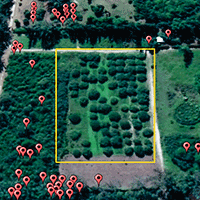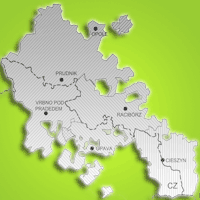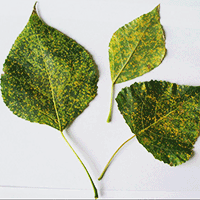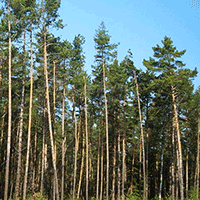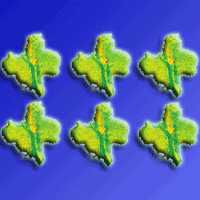Mesquite trees continue to invade forests and range lands in many countries across the world. The cost to remove these trees is staggering. In Texas, landowners spent $25 million over a 10-year period to clear 300.000 ha of mesquite trees, a fraction of the 22 million ha of Texas land affected by this invasion. Estimates are that the mesquite continues to negatively impact one to two percent of additional land in selected counties each year in Texas. However, the problem is not unique to Texas, but rather to the 44 species of mesquite trees, belonging to the genus Prosopis found in the pea family (Fabaceae), introduced across the southern United States, South Asia, Africa, the Middle East, South America, and the Caribbean. In response, researchers are searching for economically viable uses for harvested trees and seeds to provide an alternative to the high cost of removal. If viable uses for harvested mesquite trees and seeds are found, then sustained pressure will limit and ultimately reduce the negative impact from these invasive trees. One key factor to controlling this invasive species is to find economically and environmentally sustainable uses to help pay the costs of removal or perhaps make removal less necessary. Traditional uses of mesquite are as a building material, as a source of food for both animals and humans and as wood for charcoal. Emerging uses of mesquite are new applications as a biofuel and as a bio-filter medium for water. Moreover, forestry land management of mesquite has adapted to include the tree as a component of hunting lands. New control methodologies and technologies are based on an increased understanding of mesquite growth patterns, using recommended practices that reduce control and eradication costs while improving the efficiency of land management. Previous land management practices have proven that excessive application of herbicides, physical removal of mesquite trees, or human-induced brush fires, if not carefully planned, only worsen mesquite infestations. The growing problem of mesquite land management provides an opportunity for continued research into novel ways to utilize mesquite biomass, of both wood and seed pods.
Keywords
, , ,
Citation
Ellsworth SW, Crandall PG, Lingbeck JM, O’Bryan CA (2018). Perspective on the control of invasive mesquite trees and possible alternative uses. iForest 11: 577-585. - doi: 10.3832/ifor2456-011
Academic Editor
Michele Carbognani
Paper history
Received: Apr 06, 2017
Accepted: Jul 10, 2018
First online: Sep 25, 2018
Publication Date: Oct 31, 2018
Publication Time: 2.57 months
© SISEF - The Italian Society of Silviculture and Forest Ecology 2018
Open Access
This article is distributed under the terms of the Creative Commons Attribution-Non Commercial 4.0 International (https://creativecommons.org/licenses/by-nc/4.0/), which permits unrestricted use, distribution, and reproduction in any medium, provided you give appropriate credit to the original author(s) and the source, provide a link to the Creative Commons license, and indicate if changes were made.

Breakdown by View Type
(Waiting for server response...)
Article Usage
Total Article Views: 62019
(from publication date up to now)
Breakdown by View Type
HTML Page Views: 53592
Abstract Page Views: 3365
PDF Downloads: 4102
Citation/Reference Downloads: 14
XML Downloads: 946
Web Metrics
Days since publication: 2639
Overall contacts: 62019
Avg. contacts per week: 164.51
Article Citations
Article citations are based on data periodically collected from the Clarivate Web of Science web site
(last update: Mar 2025)
Total number of cites (since 2018): 7
Average cites per year: 0.88
Publication Metrics
by Dimensions ©
Articles citing this article
List of the papers citing this article based on CrossRef Cited-by.
(1)
Adams JP, Lingbeck JM, Crandall PG, Martin EM, O’Bryan CA (2015)Sweetgum: a new look. iForest - Biogeosciences and Forestry 8: 719-727.
CrossRef |
Gscholar
(2)
AMS (2016)National honey report. Agricultural Marketing Service, US Department of Agriculture, St. Louis, MO, USA, vol 38, no. 6, pp. 9.
Online |
Gscholar
(3)
Ansley JR, Huddle RJ, Kramp JA (1997)Mesquite ecology. In: “Brush sculptors: Innovations for tailoring brushy rangelands to enhance wildlife habitat and recreational value”. Texas Agricultural Experiment Station, Vernon, TX, USA, web site.
Online |
Gscholar
(4)
Ansley JR, Wu BX, Kramp B (2001)Observation: long-term increases in mesquite canopy cover in a North Texas savanna. Journal of Range Management 54: 171-176.
CrossRef |
Gscholar
(5)
Ansley RJ, Pinchak WE, Teague WR, Kramp BA, Jones DL, Jacoby PW (2004)Long-term grass yields following chemical control of honey mesquite. Journal of Range Management 57: 49-57.
CrossRef |
Gscholar
(6)
Ansley RJ, Kramp BA, Jones DL (2006)Converting mesquite thickets to savanna through foliage modification with clopyralid. Journal of Range Management 56: 72-80.
CrossRef |
Gscholar
(7)
Ansley RJ, Mirik M, Castellano MJ (2010)Structural biomass partitioning in regrowth and undisturbed mesquite (
Prosopis glandulosa): implications for bioenergy uses. Global Change Biology Bioenergy 2: 26-36.
CrossRef |
Gscholar
(8)
Ansley JR, Kramp BA, Jones DL (2015)Honey mesquite (
Prosopis glandulosa) seedling responses to seasonal timing of fire and fireline intensity. Rangeland Ecology and Management 68: 194-203.
CrossRef |
Gscholar
(9)
Archer S, Schimel DS, Holland EA (1995)Mechanisms of shrubland expansion: land use, climate or CO
2? Climate Change 29: 91-99.
CrossRef |
Gscholar
(10)
Aysu T, Durak H (2016)Bio-oil production via catalytic supercritical liquefaction of Syrian mesquite (
Prosopis farcta). Journal of Supercritical Fluids 109: 26-34.
CrossRef |
Gscholar
(11)
Babiker A (2006)Mesquite (
Prosopis spp.) in Sundan: history, distribtuion and control. In: “Problems posed by the introduction of
Prosopis in selected countries”. FAO, Rome, Italy, pp. 11-20.
Gscholar
(12)
Barak S, Mudgil D (2014)Locust bean gum: processing, properties and food applications - A review. International Journal of Biological Macromolecules 66: 74-80.
CrossRef |
Gscholar
(13)
Boggie MA, Strong CR, Lusk D, Carleton SA, Gould WR, Howard RL, Nichols C, Falkowski M, Hagen C (2017)Impacts of mesquite distribution on seasonal space use of lesser prairie-chickens. Rangeland Ecology and Management 70: 68-77.
CrossRef |
Gscholar
(14)
Bovey RW, Whisenant SG (1991)Control of honey mesquite with clopyralid, triclopyr, or clopyralid: triclopyr mixtures. Journal of Range Management 44: 52-55.
CrossRef |
Gscholar
(15)
Bravo L, Grados N, Saura-Calixto F (1998)Characterization of syrups and dietary fiber obtained from mesquite pods (
Prosopis pallida L.). Journal of Agricultural and Food Chemistry 46: 1727-1733.
CrossRef |
Gscholar
(16)
Burkart A (1976)A monograph of the genus
Prosopis (Leguminosae subfam. Mimosoideae). Journal of the Arnold Arboretum 57: 219-249.
Online |
Gscholar
(17)
Canadell J, Jackson RB, Ehleringer JB, Mooney HA, Sala OE, Schulze ED (1996)Maximum rooting depth of vegetation types at the global scale. Oecologia 108: 583-595.
CrossRef |
Gscholar
(18)
Cairns MA, Lackey RT (1992)Biodiversity and management of natural resources: the issues. Fisheries 17: 6-10.
CrossRef |
Gscholar
(19)
Chen W, Annamalai K, Ansley RJ, Mirik M (2012)Updraft fixed bed gasification of mesquite and juniper wood samples. Energy 41: 454-461.
CrossRef |
Gscholar
(20)
Chen W, Thanapal SS, Annamalai K, Ansley RJ (2015)Liquid yield from juniper and mesquite bio-fuel gasification. International Journal of Energy Research 39: 621-633.
CrossRef |
Gscholar
(21)
Collins CDH, Kautz MA, Tiller R, Lohani S, Ponce-Campos G, Hottenstein J, Metz LJ (2015)Development of an integrated multiplatform approach for assessing brush management conservation efforts in semiarid rangelands. Journal of Applied Remote Sensing 9 (1): 96057.
CrossRef |
Gscholar
(22)
DeLoach C (1984)Conflicts of interest over beneficial and undesirable aspects of mesquite (
Prosopis spp.) in the United States as related to biological control. In: Proceedings of the “6th International Symposium on Biological Control”. Vancouver (BC, Canada) 19-25 Aug 1984. Canadian Government Publ. Centre, Ottawa, Canada, pp. 301-340.
Gscholar
(23)
Dickinson E (2003)Hydrocolloids at interfaces and the influence on the properties of dispersed systems. Food Hydrocolloids 17: 25-39.
CrossRef |
Gscholar
(24)
Dudley BD, Hughes RF, Ostertag R (2014)Groundwater availability mediates the ecosystem effects of an invasion of
Prosopis pallida. Ecological Applications 24: 1954-1971.
CrossRef |
Gscholar
(25)
Ewens M, Gezan S, Felker P (2012)Five year field evaluation of
Prosopis alba clones on pH 9-10 soils in Argentina selected for growth in the greenhouse at seawater salinities (45 dS m
-1). Forests 3: 95-113.
CrossRef |
Gscholar
(26)
FAOSTAT (2016)Production quantities of carobs by country. FAO, Rome, Italy, web site.
Online |
Gscholar
(27)
Felker P, Meyer JM, Gronski SJ (1990)Application of self-thinning in mesquite (
Prosopis glandulosa var.
glandulosa) to range management and lumber production. Forest Ecology and Management 31: 225-232.
CrossRef |
Gscholar
(28)
Felker P, Takeoka G, Dao L (2013)Pod mesocarp flour of North and South American species of leguminous tree
Prosopis (mesquite): composition and food applications. Food Reviews International 29: 49-66.
CrossRef |
Gscholar
(29)
FSIS-USDA (2016)Summary of recall cases in Calendar Year 2015. Web site.
Online |
Gscholar
(30)
Fulbright TE (1996)Viewpoint: a theoretical basis for planning woody plant control to maintain species diversity. Journal of Range Management 49: 554-559.
CrossRef |
Gscholar
(31)
Geesing D, Felker P, Bingham RL (2000)Influence of mesquite (
Prosopis glandulosa) on soil nitrogen and carbon development: implications for global carbon sequestration. Journal of Arid Environment 46: 157-180.
CrossRef |
Gscholar
(32)
Grados N, Cruz G (1996)New approaches to industrialization of algarrobo (
Prosopis pallida) pods in Peru. In: Proceedings of the Workshop “
Prosopis Semiarid Fuelwood and Forage Tree Building Consensus for the Disenfranchised” (Falker P, Moss J eds). Washington (DC, USA) 13-15 Mar 1996. US National Academy of Sciences, Washington, DC, USA, pp. 3.25-3.42.
Online |
Gscholar
(33)
Hamilton WT, McGinty A, Ueckert DN, Hanselka CW, Lee MR (2004)Brush management: past, present, future (1st edn). Texas A&M University Press, College Station, TX, USA, pp. 297.
Online |
Gscholar
(34)
Hardwood (2016)Hardwood review global. Hardwood Publishing Inc., Charlotte, NC, USA, web site.
Online |
Gscholar
(35)
Jackson RB, Canadell J, Ehleringer JR, Mooney HA, Sala OE, Schulze ED, Mooney HA (1996)A global analysis of root distributions for terrestrial biomes. Oecologia 108 (3): 389-411.
CrossRef |
Gscholar
(36)
Johnson HB, Polley HW, Whitis RP (2000)Elongated chambers for field studies across atmospheric CO
2 gradients. Functional Ecology 14: 388-396.
CrossRef |
Gscholar
(37)
Lee SG, Felker P (1992)Influence of water/heat stress on flowering and fruiting of mesquite (
Prosopis glandulosa var.
glandulosa). Journal of Arid Environments 23: 309-319.
Gscholar
(38)
López-Franco YL, Goycoolea FM (2006)Goma de mezquite: una alternativa de uso industrial [Mesquite gum: an alternative industrial use]. Interciencia 31: 183-189. [in Spanish]
Gscholar
(39)
López Villagra GM, Felker P (1997)Influence of understory removal, thinning and P fertilization on N
2 fixation in a mature mesquite (
Prosopis glandulosa var.
glandulosa) stand. Journal of Arid Environment 36: 591-610.
CrossRef |
Gscholar
(40)
NASS (2016)Honey bee surveys and reports. National Agricultural Statistics Service, US Department of Agriculture, web site.
Online |
Gscholar
(41)
Patch NL, Felker P (1997)Silvicultural treatments for sapling mesquite (
Prosopis glandulosa var.
glandulosa) to optimize timber production and minimize seedling encroachment. Forest Ecology and Management 96: 231-240.
CrossRef |
Gscholar
(42)
Polley HW, Johnson HB, Tischler CR (2003)Woody invasion of grasslands: evidence that CO
2 enrichment indirectly promotes establishment of
Prosopis glandulosa. Plant Ecology 164: 85-94.
CrossRef |
Gscholar
(43)
Randall RC, Phillips GO, Williams PA (1988)The role of the proteinaceous component on the emulsifying properties of gum arabic. Food Hydrocolloids 2: 131-140.
CrossRef |
Gscholar
(44)
Rogers KE (1986)The wood properites of Mesquite (
Prosopis glandulosa var.
glandulosa): its basic properties and variability. Texas Forest Service, College Station, Texas, USA, vol. 40.
Gscholar
(45)
Rogers KE (2000)The magnificent mesquite (1st edn). University of Texas Press, Austin, TX, USA, pp. 167.
Online |
Gscholar
(46)
Román-Guerrero A, Orozco-Villafuerte J, Pérez-Orozco JP, Cruz-Sosa F, Jiménez-Alvarado R, Vernon-Carter EJ (2009)Application and evaluation of mesquite gum and its fractions as interfacial film formers and emulsifiers of orange peel-oil. Food Hydrocolloids 23: 708-713.
CrossRef |
Gscholar
(47)
Sciammaro L, Ferrero C, Puppo MC (2016)Chemical and nutritional properties of different fractions of
Prosopis alba pods and seeds. Journal of Food Measurement and Characterization 10: 103-112.
CrossRef |
Gscholar
(48)
Shackleton RT, Le Maitre DC, Pasiecznik NM, Richardson DM (2014)Prosopis: a global assessment of the biogeography, benefits, impacts and management of one of the world’s worst woody invasive plant taxa. AoB Plants 6: 1-18.
CrossRef |
Gscholar
(49)
Shackleton RT, Le Maitre DC, Richarson DM (2015)Stake holder perceptions and practices
Prosopis (mesquite) invasions and management in South Africa. Ambio 44 (6): 569-581.
CrossRef |
Gscholar
(50)
Soper FM, Boutton TW, Sparks JP (2015)Investigating patterns of symbiotic nitrogen fixation during vegetation change from grassland to woodland using fine scale δ(15)N measurements. Plant, Cell and Environment 38: 89-100.
CrossRef |
Gscholar
(51)
Sosa-Hernandez DB, Vigueras-Cortes JM, Garzon-Zuniga MA (2016)Mesquite wood chips (
Prosopis) as filter media in a biofilter system for municipal waste water treatment. Water Science and Technology 73: 1454-1462.
CrossRef |
Gscholar
(52)
Stromberg JC, Wilkins SD (1993)Vegetation-Hydrology Models: Implications for management of
Prosopis velutina (velvet mesquite) riparian ecosystems. Ecological Applications 3 (2): 307-314.
CrossRef |
Gscholar
(53)
Takeoka G, Felker P, Prokopiuk D, Dao L (2008)Volatile constituents of mesquite (
Prosopis) pods. In: “Food Flavor: Chemistry, Sensory Evaluation, and Biological Activity” (Tamura H, Ebeler SE, Kubota K, Takeoka GR eds). American Chemical Society, Washington, DC, vol. 988, pp. 98-108.
CrossRef |
Gscholar
(54)
Teague WR, Ansley RJ, Kreuter UP, Pinchack WE, McGrann JM (2001)Economics of managing mesquite in north Texas: a sensitivity analysis. Journal of Range Management 54 (5): 553-560.
CrossRef |
Gscholar
(55)
Texas A&M Agrilife Extension (2016)How to estimate cost for controlling mesquite. Texas A&M Agrilife Extension, College Station, TX, USA, web site.
Online |
Gscholar
(56)
TimberMart-South (2016)South-wide averages price. Center for Forest Business, Warnell School of Forestry and Natural Resources, University of Georgia, Atlanta, GE, USA, web site.
Online |
Gscholar
(57)
TSSWCB (2010)Agency reports. Texas State Soil and Water Conservation Board 1-8, Temple, TX, USA, web site.
Online |
Gscholar
(58)
Van Klinken RD, Fichera G, Cordo H (2003)Targeting biological control across diverse landscapes: the release, establishment, and early success of two insects on mesquite (
Prosopis spp.) insects in Australian rangelands. Biology Control 26: 8-20.
CrossRef |
Gscholar
(59)
Vasile FE, Martinez MJ, Pizones Ruiz-Henestrosa VM, Judis MA, Mazzobre MF (2016)Physicochemical, interfacial and emulsifying properties of a non-conventional exudate gum (
Prosopis alba) in comparison with gum arabic. Food Hydrocolloids 56: 245-253.
CrossRef |
Gscholar
(60)
Velarde M, Felker P, Degano C (2003)Evaluation of argentine and peruvian
Prosopis germplasm for growth at seawater salinities. Journal Arid Environment 55: 515-531.
CrossRef |
Gscholar
(61)
Wang M, Han J, Dunn JB, Cai H, Elgowainy A (2012)Well-to-wheels energy use and greenhouse gas emissions of ethanol from corn, sugarcane and cellulosic biomass for US use. Environment Research Letters 7: 45905.
CrossRef |
Gscholar
(62)
Wang T, Park S, Ansley RJ, Amosson SH (2014)Economic and greenhouse gas efficiency of honey mesquite relative to other energy feedstocks for bioenergy uses in the Southern Great Plains. Bioenergy Research 7: 1493-1505.
CrossRef |
Gscholar
(63)
Wilson TB, Thompson TL (2005)Soil nutrient distributions of mesquite-dominated desert grasslands: changes in time and space. Geoderma 126: 301-315.
CrossRef |
Gscholar
(64)
Wise RM, Van Wilgen BW, Le Maitre DC (2012)Costs, benefits and management options for an invasive alien tree species: the case of mesquite in the Northern Cape, South Africa. Journal of Arid Environment 84: 80-90.
CrossRef |
Gscholar


